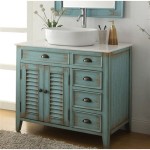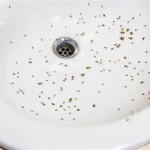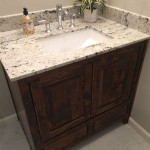Porcelain Antique Bathroom Vanity: A Timeless Elegance
The porcelain antique bathroom vanity represents a compelling blend of functionality and artistry. These vanities, often dating back to the late 19th and early 20th centuries, evoke a sense of historical charm and sophistication that can transform an ordinary bathroom into a captivating and elegant space. Understanding the defining characteristics, historical context, and practical considerations of choosing and maintaining a porcelain antique bathroom vanity is crucial for those seeking to incorporate this timeless piece into their homes.
The Distinctive Characteristics of Porcelain Vanities
Porcelain vanities from the antique era are distinguished by several key features. The most prominent is the use of porcelain itself, a hard, non-porous ceramic material known for its durability, stain resistance, and smooth, glossy finish. This material was prized for its hygienic properties and aesthetic appeal, making it an ideal choice for bathroom fixtures.
The design of these vanities frequently incorporates intricate detailing. Hand-painted floral motifs, subtle relief patterns, and decorative molding were common embellishments, reflecting the artistic sensibilities of the period. The porcelain basins are often generously sized and feature graceful curves and contours, contributing to the overall elegance of the piece. The color palettes tend to be muted and refined, with soft creams, whites, and pastel shades predominating, punctuated occasionally by richer hues in the painted decorations.
The construction of an antique porcelain vanity typically involves a combination of materials. While the sink basin and countertop are crafted from porcelain, the base is often made from wood, such as oak, walnut, or mahogany. The wooden base provides structural support and can feature ornate carvings, turned legs, and period-appropriate hardware, such as brass faucets and drawer pulls. The interplay between the pristine porcelain and the warm wood creates a visually striking contrast, enhancing the vanity's overall appeal.
Another defining characteristic is the presence of an integrated backsplash. This raised section behind the sink protects the wall from water splashes and often features decorative details that complement the sink basin's design. The backsplash serves both a functional and aesthetic purpose, contributing to the vanity's cohesive and polished appearance.
Historical Context and Evolution of the Porcelain Vanity
The emergence of the porcelain antique bathroom vanity is closely tied to the advancements in plumbing and sanitation during the late 19th century. As indoor plumbing became more widespread, the demand for functional and aesthetically pleasing bathroom fixtures increased. Porcelain, with its hygienic properties and ease of cleaning, quickly became a favored material for sinks and bathtubs.
Early porcelain vanities were often simple, utilitarian designs, prioritizing functionality over ornamentation. However, as the Victorian era progressed, the emphasis shifted towards more elaborate and decorative designs. Manufacturers began experimenting with different shapes, sizes, and decorative techniques, creating a diverse range of vanities to suit various tastes and budgets.
The Art Nouveau movement, with its emphasis on flowing lines, organic forms, and natural motifs, had a significant influence on the design of porcelain vanities during the late 19th and early 20th centuries. Floral patterns, stylized leaves, and depictions of birds and insects were frequently incorporated into the painted decorations, reflecting the aesthetic values of the era.
The Arts and Crafts movement, which championed handcrafted quality and simplicity, also left its mark on porcelain vanity design. Vanities produced during this period often featured clean lines, minimal ornamentation, and a focus on the natural beauty of the materials. The wooden bases were typically made from solid hardwoods and finished with a clear varnish to showcase the wood grain.
The popularity of porcelain vanities continued into the early 20th century, with various styles emerging to reflect the changing tastes of the time. Art Deco vanities, for example, featured geometric patterns, bold colors, and a sense of modern sophistication. However, the advent of mass-produced, less expensive materials gradually led to a decline in the production of high-quality porcelain antique vanities. Today, these vanities are highly valued as vintage treasures, representing a bygone era of craftsmanship and elegance.
Considerations for Selecting and Maintaining a Porcelain Antique Vanity
Choosing a porcelain antique bathroom vanity requires careful consideration of several factors. The first is the overall condition of the vanity. Antique pieces may exhibit signs of wear and tear, such as minor chips, cracks, or stains. While some imperfections can add to the vanity's character, it is essential to assess the extent of the damage and determine whether it can be repaired or restored. A professional restorer can often repair cracks, chips, and stains in porcelain, restoring the vanity to its former glory.
The size and dimensions of the vanity are also crucial considerations. It is important to ensure that the vanity will fit comfortably within the available space in the bathroom and that its height is appropriate for the intended users. Measuring the bathroom carefully and comparing the dimensions to the vanity's specifications is essential before making a purchase.
The style of the vanity should complement the overall design aesthetic of the bathroom. A Victorian-style vanity, for example, may be best suited for a bathroom with traditional features, such as clawfoot tubs, wainscoting, and antique lighting fixtures. An Art Deco vanity, on the other hand, may be more appropriate for a bathroom with a more modern or streamlined design.
The functionality of the vanity is another important consideration. Ensure that the sink basin is an appropriate size and shape for its intended use and that the vanity provides adequate storage space for toiletries and other bathroom essentials. Inspect the faucets and plumbing fixtures to ensure that they are in good working order and compatible with the existing plumbing system.
Maintaining a porcelain antique bathroom vanity requires regular cleaning and care. Porcelain is relatively easy to clean, but it is important to avoid using abrasive cleaners or scrub brushes that could scratch the surface. A mild soap and water solution is typically sufficient for removing dirt and grime. For stubborn stains, a paste made from baking soda and water can be applied to the affected area and gently scrubbed with a soft cloth.
The wooden base of the vanity should be cleaned and polished regularly to protect it from moisture and maintain its luster. A furniture polish specifically designed for wood can be used to clean and protect the wood surface. Avoid placing wet items directly on the wood surface, as this can cause water damage.
Periodically inspect the plumbing connections for leaks and corrosion. Replacing worn or damaged plumbing fixtures can prevent more serious problems in the future. Consider consulting a professional plumber for any repairs or maintenance that requires specialized knowledge or tools.
Protecting the vanity from excessive moisture is also important. Ensure that the bathroom is well-ventilated to prevent the buildup of humidity. Consider using a dehumidifier if the bathroom is prone to dampness. Promptly wipe up any spills or water splashes to prevent staining or water damage.
Finally, consider the environmental impact of choosing an antique vanity. By repurposing an existing piece, one contributes to sustainable practices, reducing the demand for new manufacturing and minimizing waste. Antique vanities, when properly cared for, can last for generations, making them a worthwhile investment in both style and sustainability.

Buy Bathroom Vanity Vessel Ceramic Sink Antique Washbasin Half In

Buy Green Aged Brushed Brass Bathroom Vanity Sink Antique In

Home Decorators Collection Winslow 33 In W X 22 D 35 H Single Sink Freestanding Bath Vanity Antique Cherry With White Porcelain Top Bf 27001 Ac The Depot

Chinese Antique Hand Made Lotus Design Bathroom Cabinet Counter Top Porcelain Wash Sink China Ceramic Basin In Com

Chinese Antique Hand Made Lotus Design Bathroom Cabinet Counter Top Porcelain Wash Sink China Ceramic Basin In Com

Pin On S

Antique Sideboard Buffet Turned Into Double Sink Vanity Traditional Bathroom Portland By Julie Murray Houzz

Home Decorators Collection Winslow 26 In W X 22 D 35 H Single Sink Freestanding Bath Vanity Antique Gray With White Porcelain Top Bf 27000 Ag The Depot

Vintage Bathroom Vanities

Vintage Bathroom Vanity
Related Posts







